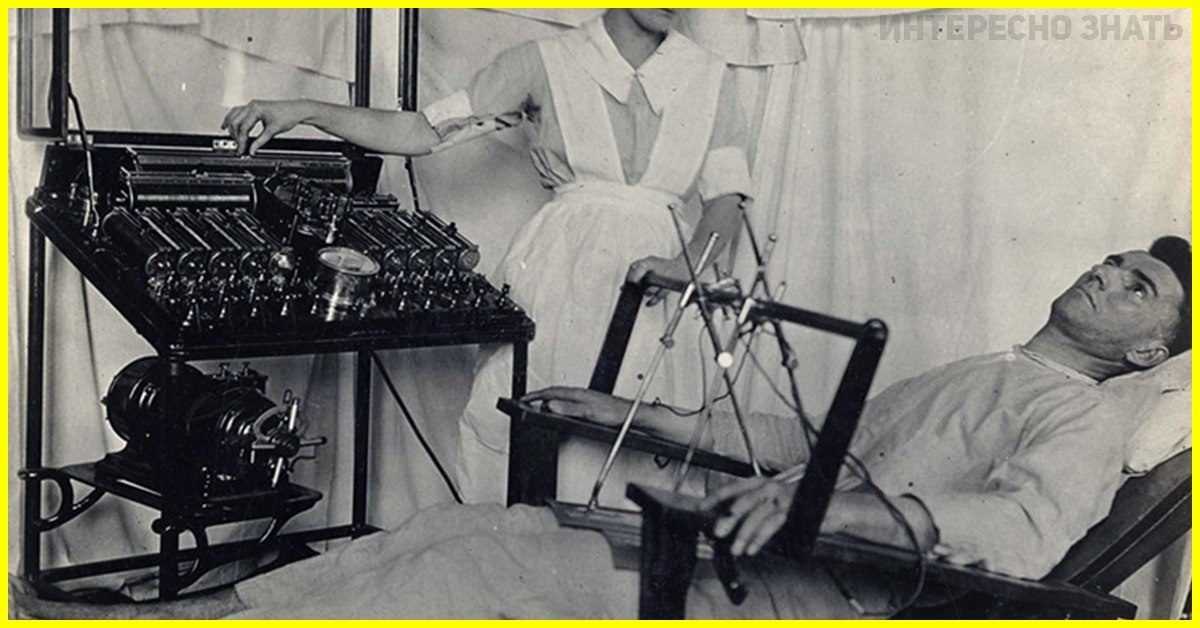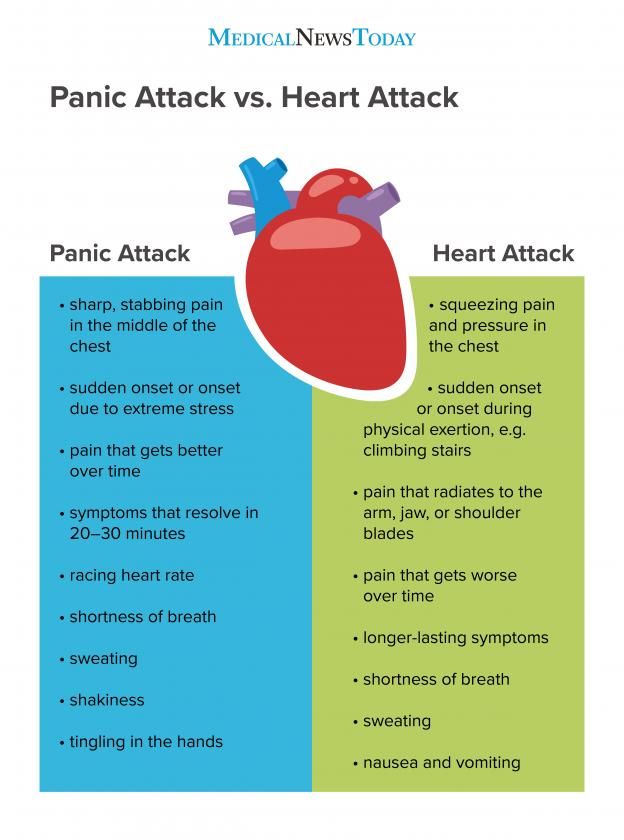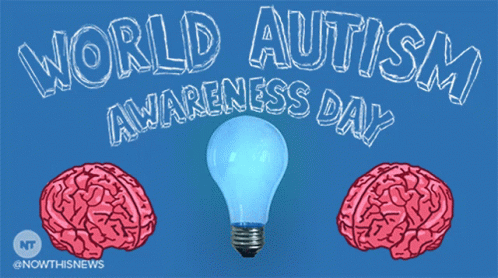I have an addiction to chocolate
What Are The Chocolate Addiction Signs
Chocolate addiction is the uncontrolled consumption of large amounts of chocolate despite adverse health consequences. A negative relationship with chocolate may manifest in psychological and behavioral ways.
The symptoms of chocolate addiction include intense cravings for chocolate, continuous consumption of chocolate past the point of fullness, and the inability to control chocolate intake despite health consequences. There are several reasons behind a person’s addiction to chocolate.
The causes of compulsive chocolate consumption are chocolate’s addictive properties, the stimulation of pleasure chemicals in the brain, and feelings of stress and anxiety. The condition also has several negative health impacts on a person.
The effects of chocolate addiction include eating disorders, obesity, feelings of guilt, self-loathing, depression, and anxiety. These health issues often occur as a result of eating chocolate in excess.
Table of Contents
What is Chocolate addiction?
Chocolate addiction is the lack of control over chocolate consumption that is characterized by intense cravings for the food. A chocolate addict may also continue eating the treat regularly despite being aware of resulting health problems.
These addiction-like responses are largely attributed to the feel-good reaction that chocolates can trigger in a person.
What are the causes of Chocolate addiction?
Causes behind regular chocolate consumption can vary widely from person to person. The causes of chocolate addiction are listed below.
- Biological factors: A person’s preference for sweet foods can be due to genetics and the stimulation of the brain’s reward system caused by chocolates. Evidence exists that children of parents with alcohol problems are more likely to develop a preference for sugary foods like chocolate. Addictive-like eating behavior around chocolate also stems from its ability to increase levels of neurotransmitters such as dopamine and serotonin, which are both critical for appetite and positive mood.

- Psychological factors: Negative emotions such as stress, anxiety, and depression can make people turn to chocolate for comfort and reassurance. Some people also tend to associate chocolate with comfort food, which is craved for when in need of a mood boost.
- Social factors: Chocolate is depicted in the media or in advertisements as either an indulgence or something one should be guilty about. This may influence increased consumption to the point of abuse, as people are exposed to images of chocolate and helpless chocoholics everywhere.
Addictive behavior around sugary foods may result in health problems. The effects of chocolate addiction are listed below.
- Physical effects: Excessive consumption of chocolate can lead to physical issues, including weight gain, obesity, elevated blood sugar levels, and breakouts in acne-prone skin.
 Chocolate and other sweet foods may alter blood sugar levels.
Chocolate and other sweet foods may alter blood sugar levels.
Research also suggests that consuming large amounts of refined sugars may worsen existing acne problems or cause new breakouts in the skin. - Psychological effects: Chocolates can affect people’s emotions in both positive and negative ways. The psychological effects of chocolate addiction include elevated mood, feelings of euphoria, mood swings, and addiction-like cravings.
The release of serotonin and dopamine triggered by chocolate helps with mood regulation but can also cause a person to repeatedly eat chocolate to achieve pleasurable feelings. The fat in chocolate may also act similar to heroin and produce euphoric feelings. Moreover, some chemicals in chocolate may cause a short period of emotional highs and lows. - Short-term effects: Eating too much chocolate can have short-term effects, including a sudden boost in mood, nausea, headaches, and blood pressure spikes.
 The tyramine in chocolate is known as a common migraine trigger and also promotes a sudden increase in blood pressure, which can be accompanied by nausea and headaches.
The tyramine in chocolate is known as a common migraine trigger and also promotes a sudden increase in blood pressure, which can be accompanied by nausea and headaches. - Long-term effects: Overconsumption of chocolate may lead to long-term health risks, including acid reflux, heartburn, fast heartbeat, and sleep problems. The cocoa in chocolate is acidic and may cause gastrointestinal issues, including acid reflux and heartburn.
The caffeine content of cocoa may also result in side effects such as sleeplessness and a fast heartbeat.
What are the signs and symptoms of Chocolate addiction?
Addictive behavior around sugary foods may result in health problems. The effects of chocolate addiction are listed below.
- Intense chocolate cravings: The high sugar and fat content of many chocolates can trigger addiction-like cravings. Eating chocolate has been found to activate regions of the brain that regulate cravings and rewards, which is the same pattern of brain activity seen in drug addiction.

- Continuous consumption of chocolate past the point of fullness: Chocolate addicts often have no control over the amount of chocolate they eat. As a result, people addicted to chocolate may continue eating the food even after feeling full.
- Inability to control chocolate intake despite health consequences: Overconsumption of chocolate may contribute to weight gain, obesity, and other health problems. A chocolate addict may, however, ignore obvious health effects due to loss of control over the object of addiction.
- Lying to friends and family about overconsumption of chocolate: Someone who is addicted to chocolate may keep their obsession a secret from family or friends to cover feelings of shame and protect their vulnerability.
- Feelings of guilt over eating chocolate: When one bar of chocolate quickly turns into the need to eat a whole box, one may experience feelings of guilt after eating the treat.
 However, a chocolate addict may repeat the behavior despite negative feelings, keeping the cycle of addiction going.
However, a chocolate addict may repeat the behavior despite negative feelings, keeping the cycle of addiction going.
Other possible chocolate addiction symptoms include:
- Making excuses to have more chocolate
- Eating more chocolate than originally intended
- Having an uncontrollable urge to eat the treat despite feeling full
- Attempting to set rules around snacking chocolate but repeatedly failing
How to overcome chocolate addiction?
One can overcome food addiction by practicing mindful eating. The practice of mindful eating involves developing awareness around the food that one eats and recognizing physical cues when eating.
A chocolate addict may start by putting a limit on how much chocolate they are going to eat per day or week. If needed, a person may completely cut chocolate out of their diet and look for alternative snacks that are lower in sugar and fat.
It is also beneficial to listen to physical hunger cues and only eat until full. Gaining a deeper understanding of the root causes and triggers of one’s chocolate addiction is also a crucial step in overcoming an unhealthy relationship with chocolate.
Gaining a deeper understanding of the root causes and triggers of one’s chocolate addiction is also a crucial step in overcoming an unhealthy relationship with chocolate.
What are the risk factors for Chocolate addiction?
Certain groups of people are more likely to develop an addiction to chocolate. The risk factors for chocolate addiction are listed below.
- Eating disorders:
Chocolate craving has been associated with eating disorders. People who struggle with abnormal eating behaviors may be more likely to develop an addiction to chocolate.
- Obesity:
Binge eating disorder, loss of control over eating, and food addiction are more common in obese people. As a result, people who suffer from obesity may also struggle with a form of disordered eating that can involve chocolates.
- Magnesium deficiency:
Chocolate cravings may result from magnesium deficits. Some people may feel the need to consume chocolate to increase magnesium levels as chocolate is high in magnesium.
- Emotional eating:
Evidence exists that chocolate has stronger effects on people who emotionally eat. Individuals who engage in emotional eating often associate chocolates with comfort and may feel guilt or shame after overconsumption of the food.
How do you treat Chocolate addiction?Chocolate addiction can be treated by talking to a mental healthcare professional about the problem. A therapist may help a chocolate addict gain a better understanding of the underlying causes of their addiction and provide a plan to overcome the condition.
A counseling session is also beneficial in avoiding possible triggers of chocolate addiction by developing healthier coping mechanisms when faced with intense cravings. Treating chocolate addiction can also be done with the assistance of other medical professionals such as a physician and nutritionist who may help reverse the physical impacts of chocolate addiction on a person’s body.
Why is Chocolate addictive?
Chocolate is addictive because it is loaded with sugar and fat that trigger brain reward pathways. In general, highly processed foods including chocolates are considered more addictive than foods with minimal processing.
Chocolate is a food product obtained from Theobroma cacao tree seeds. Aside from eating, chocolate may also be used for other purposes, including making cocktails, as a dipping sauce, and as a garnish for desserts.
Chocolate has several proven benefits. The advantages of a healthy relationship with chocolate include lowered risk of stroke, better heart health, a resilient immune system, and improved brain function.
In some cases, however, overconsumption of chocolate may lead to adverse consequences. The disadvantages of chocolate include obesity, acne, diabetes, high blood pressure, mood swings, acid reflux, heartburn, and the risk for addiction.
One of the many reasons why chocolate is addictive has something to do with its interaction with a brain chemical called enkephalin. Enkephalin is a naturally occurring brain chemical that activates opioid receptors, which are receptors that respond to opiates like morphine. Eating chocolate increases levels of enkephalin, which in turn results in the need to consume more chocolates.
Enkephalin is a naturally occurring brain chemical that activates opioid receptors, which are receptors that respond to opiates like morphine. Eating chocolate increases levels of enkephalin, which in turn results in the need to consume more chocolates.
Another reason behind chocolate’s addictive potential is a stimulating chemical called theobromine. Theobromine, when combined with caffeine, has positive effects on a person’s mood and also causes an aphrodisiac boost.
When is Chocolate addiction counseling necessary?
Chocolate addiction counseling is necessary when providing support to patients and involving families in the recovery process. With the help of counseling, a person can identify and overcome chocolate-related problems as well as learn coping strategies that will help them resist chocolate cravings. This way, the addicted person gains a new perspective on the condition, leading to a healthier relationship with chocolate.
Educating family members through counseling is another crucial part of the recovery process. Family involvement in chocolate addiction treatment and recovery helps prevent a relapse and address issues at home that may have contributed to the addiction.
Family involvement in chocolate addiction treatment and recovery helps prevent a relapse and address issues at home that may have contributed to the addiction.
What are the symptoms of Chocolate addiction withdrawal?
The symptoms of chocolate addiction withdrawal include intense cravings for sweet foods, carbohydrate cravings, increased irritability, depressed mood, headaches, lack of energy, and exhaustion.
Cutting back on chocolate may affect a person by causing withdrawal symptoms that may be uncomfortable. This happens as the body craves the release of pleasure chemicals in the brain once triggered by the overconsumption of chocolate.
Can I Be Addicted to Chocolate? I Psych Central
Chocolate: It’s irresistibly delicious, and for some people it can seem addictive. But it’s not considered an addiction.
Chocolate addiction isn’t an official diagnosis. Still, it’s possible to experience chocolate cravings and eat more than you should.
Chocolate contains ingredients — such as sugar and fat — that also exist in other addictive foods. They’re the reason many people cave to chocolate cravings.
They’re the reason many people cave to chocolate cravings.
If you want to tame your indulgence in this sweet treat, there are tips you can try that may help.
Language matters
In this article, we use the term “chocolate addiction.” While your cravings for chocolate may feel like an addiction, it’s not recognized as a clinical term and cannot be medically diagnosed. Still, it’s a common phrase people use to describe an excessive craving for and eating a lot of chocolate.
No, but it’s possible to feel like you have a chocolate addiction.
Chocolate isn’t the same as cocoa but they’re both made from the seed of cacao, or “the cocoa bean.”
Both chocolate and cocoa are the refined and processed versions of the cacao bean. Chocolate is a treat that includes ingredients such as sugar and fat. Cocoa is also an ingredient in chocolate.
Cocoa bark contains important minerals such as:
- potassium
- calcium
- phosphorus
- magnesium
So, chocolate does have some health benefits. But it has other ingredients that can cause addiction-like reactions, such as cravings and withdrawal.
But it has other ingredients that can cause addiction-like reactions, such as cravings and withdrawal.
The Diagnostic and Statistical Manual of Mental Disorders, 5th edition, text revision (DSM-5-TR) doesn’t recognize chocolate addiction as a diagnosable condition.
Instead, it contains two condition categories that may relate to chocolate addiction:
- feeding and eating disorders
- substance-related and addictive disorders
Research from 2019 found there may be a link between food addiction and eating disorders as described in the original DSM-5. The study also found that food addiction can sometimes cause impairments such as those from substance use disorder (e.g., cravings and withdrawals). This study was limited and more research is needed.
So, even though chocolate addiction isn’t a real diagnosis, it may still create addiction-like symptoms that can affect how you feel.
If you feel like you have a chocolate addiction, it’s not just because of its delicious flavor.
A concentrated dose and rapid absorption rate are two properties that many addictive substances share, and highly processed foods such as chocolate have these qualities.
A 2015 study found a connection between processed foods and addictive-like eating.
Higher glycemic load is also a factor. Glycemic load is the level of blood sugar that results from food and drink consumption. For example, a piece of sugar-containing chocolate has a higher glycemic load than a cucumber.
Glycemic load is a quality connected to foods that seem addictive. The study found that foods with a higher glycemic load that also contained fat were most frequently linked to eating behaviors that mimicked addiction.
Cocoa contains other compounds, including:
- caffeine: central nervous system (CNS) stimulant
- theobromine: plant molecule and CNS stimulant
- serotonin: neurotransmitter
- tryptophan: amino acid
- histamine: immune response chemical
- tryptamine: tryptophan metabolite
- phenylethylamine (PEA): CNS stimulant
- tyramine: amino acid
- octopamine: neurohormone
- anandamide: endocannabinoid
Some of these compounds can affect the way you feel.
For instance, tryptophan helps form the neurotransmitter serotonin, and phenylethylamine releases the neurotransmitters norepinephrine and dopamine. Serotonin and dopamine both affect mood, and norepinephrine increases alertness and attention.
Anandamide is a lipid that binds to brain cannabinoid receptors and mimics the effects of cannabis. Research from 2018 shows that anandamide affects the brain reward circuitry.
So, if chocolate makes you feel better and more alert, it can seem like it’s addictive.
While professionals may not call it a chocolate addiction, your relationship with chocolate may be causing you some distress. Some signs to watch for include:
- excessive cravings
- an inability to resist or limit your chocolate intake
- continued use, consumption, or engagement despite unwanted consequences
Cravings can occur for several reasons such as:
- nutrient deficiencies
- forbidden status
- not enough sleep
- stress
- mood
- association (such as popcorn with movies)
- dehydration
It’s helpful to assess these factors before deciding whether your symptoms are caused by an excessive craving for chocolate.
Cravings are only one of several signs that you might want to change your relationship with chocolate. Others may include:
- feeling anxiety while you eat it
- viewing it negatively
- binge eating large amounts
- hiding the amount you eat from other people
- eating it until you feel ill or experience stomach pain
- creating strict chocolate-eating rules
- eliminating it completely from your diet
These behaviors may also point to signs of an eating disorder.
It’s OK to eat a moderate amount of chocolate. But if your cravings for chocolate are impacting your daily life, it’s important to seek help.
Consider speaking with a healthcare or mental health professional about what you’re experiencing. They can provide an accurate diagnosis and refer you to an eating disorder specialist if needed.
An indication you may be eating too much chocolate is when you feel the effects of stopping. These signs are also likely because of sugar withdrawal.
As you cut down on chocolate, you might experience:
- cravings
- anxiety
- irritability
- depression
- changes in your sleep habits
- trouble concentrating
- headaches
- nausea
- fatigue
- dizziness
- light-headedness
These symptoms will likely be mild and short-lived and pass once your body has adjusted to a reduced chocolate intake.
If you’d like to eat less chocolate, there are tips you can try to make this easier.
Hydration
Food cravings can be a sign of dehydration. Sometimes thirst feels like a food craving or hunger. Try drinking some water and wait to see if the craving persists or passes.
Healthy alternatives
It’s much easier to replace than stop a behavior. To break your chocolate habit, try eating something healthier or more filling instead such as:
- fruit (fresh, frozen, or dried)
- nuts
- roasted chickpeas
- seeds (pumpkin, sunflower)
- Greek yogurt
- tuna
- peanut butter
Reduced access
You can’t eat sweets that you don’t buy.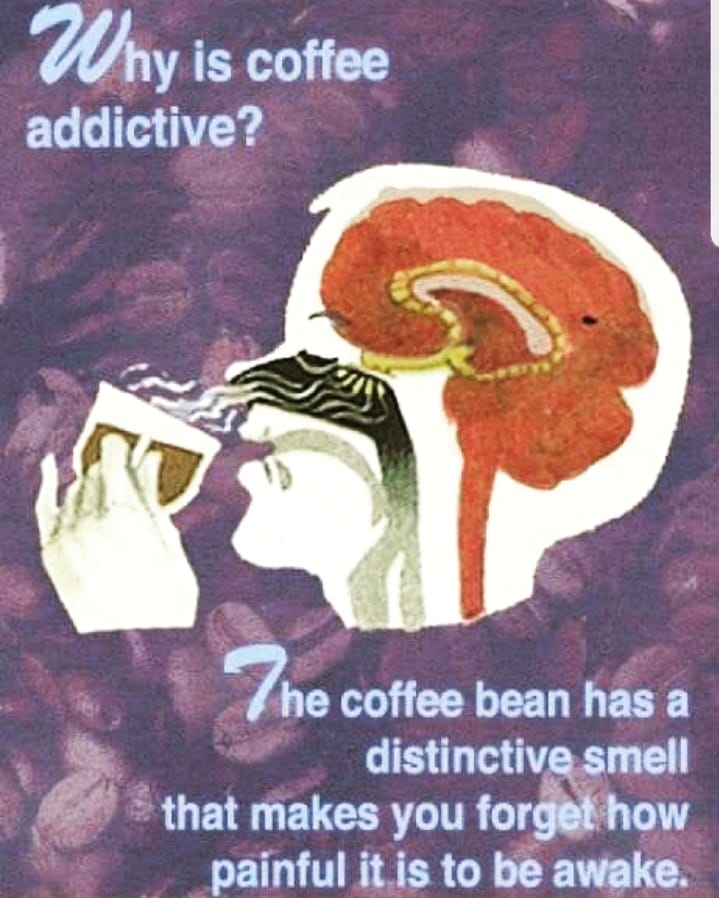 Eliminating or scaling back on chocolate purchases means you might eat it less. If it’s easier, consider having someone else do your shopping, or taking a friend with you to keep you on track.
Eliminating or scaling back on chocolate purchases means you might eat it less. If it’s easier, consider having someone else do your shopping, or taking a friend with you to keep you on track.
Redirection
If you experience a craving for chocolate, it may help to redirect your attention by doing something else. For example, try going for a walk or spending time on a hobby.
Less addictive chocolate
You can look for chocolate with less sugar and fat — the ingredients that make food more addictive. An example is dark chocolate, which may also have the most beneficial antioxidants.
If dark chocolate isn’t as sweet as you’d like, try a different treat such as a homemade smoothie. Mix unsweetened cocoa powder with a fruit such as banana and pineapple and regular or nut milk. You can also experiment by adding or changing ingredients to find a combination you like.
You may also want to try supplements made out of chocolate but also contains vitamins. The chocolate used in these supplements is often less addictive.
Stress reduction
You may have acquired a habit of turning to comfort foods such as chocolate as a way of managing stress. You can try other strategies instead, including:
- exercise
- mindfulness training
- getting enough sleep
- a less busy schedule
- a new hobby
- more social contact
Chocolate is a favorite treat for many people. It’s woven into multiple traditions and is a part of almost every special occasion.
Chocolate addiction isn’t a real diagnosis. Even so, chocolate contains ingredients that are found in the types of foods that can cause addiction-like reactions. It might still affect your life even though it’s not a diagnosable condition.
Cutting back on sweet treats such as chocolate benefits more than your physical health. Excess sugar intake can also been linked to mental health issues such as depression.
It can help to have support.
Sometimes excessive chocolate eating is part of an eating disorder. There are treatment options available that can help you regain your sense of balance and self-control.
There are treatment options available that can help you regain your sense of balance and self-control.
Excessive eating can also be a coping strategy for a mental health issues such as anxiety. You can check out Psych Central’s hub on finding mental health support for more information about finding resources and support.
causes, symptoms, possible consequences and information on how to get rid of it
Reading time: 5 minutes
AA
Addiction to chocolate appears as a result of stress, depression or mineral deficiency. To get rid of a bad mood, a person consumes a whole tile at a time.
Chocolate stimulates for 3-4 hours, after which the positive effect of the sweet disappears and there is a desire to eat another piece of dessert. Uncontrolled consumption of sweets can lead to obesity, skin problems and metabolic disorders.
What is a strong craving for chocolate?
Chocolate addiction is an uncontrollable physical and psychological addiction. A person can eat dessert several times a day, but this will not bring him saturation. A strong craving for chocolate is called chocoholism.
A person can eat dessert several times a day, but this will not bring him saturation. A strong craving for chocolate is called chocoholism.
Important!
Addiction is developed as a result of the high content of cocoa and sugar in the bar. The first consists of active substances that stimulate the production of serotonin. The vigor hormone is a compound of fatty acids that excite the central nervous system and improve the transmission of nerve impulses.
Serotonin derivatives have a hallucinogenic and stimulating effect. Therefore, after eating a tile, a person feels an uplift in mood. With the depletion of energy reserves, the body needs to receive sugar.
A sharp increase in glucose concentration stimulates the brain, increases body tone and normalizes metabolism. As a result, after several doses of chocolate, a person develops an addiction.
Causes of emergence
Addiction to chocolate is formed under the influence of several factors:
- Lack of minerals in the body.
 Chocolate contains large amounts of phosphorus, magnesium and zinc. With a deficiency of these trace elements, a person feels an acute need for sweets.
Chocolate contains large amounts of phosphorus, magnesium and zinc. With a deficiency of these trace elements, a person feels an acute need for sweets. - Psychological problems. Depression, problems in the family, emotional upheavals have a negative impact on a person's condition. He tries to eat his problems with chocolate, which stimulates the production of hormones of joy.
- Marketing advertising. A colorful presentation encourages people to buy popular products. Arriving at the store, a person on a subconscious level feels the need to purchase chocolate.
- Hormone of joy. Due to the high content of phenylethylamine and caffeine, chocolate stimulates the production of serotonin in the anterior pituitary gland.
The active substance has a tonic effect on the body and gives a feeling of pleasure. Because of this, a person tries to eat more chocolate in order to feel joy and a surge of energy.
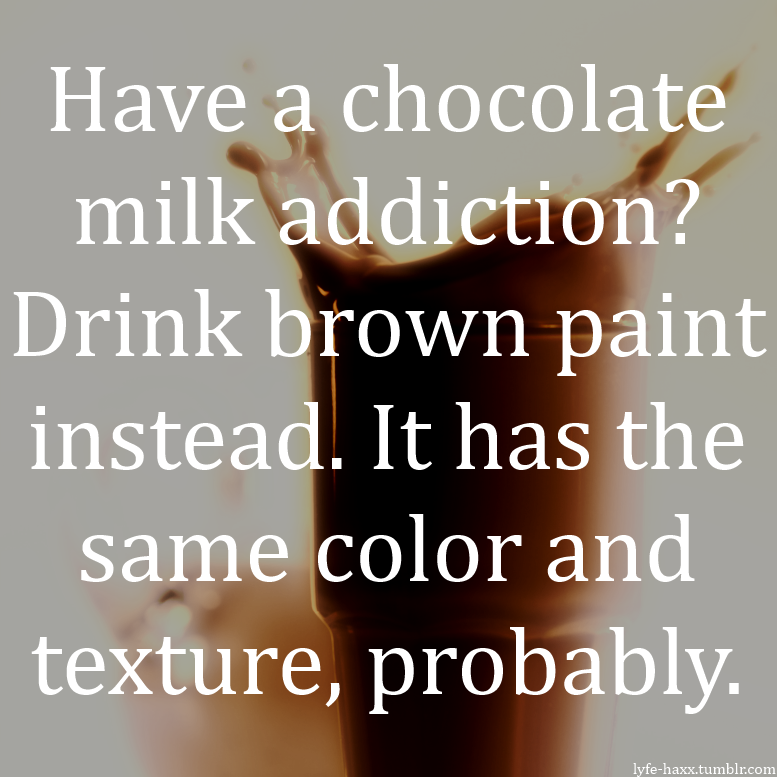
- Menstruation. During this period, a woman feels an acute lack of magnesium, and tries to make up for it. Chocolate compensates for the lack of minerals, stabilizes hormonal levels and improves mood.
Attention!
Children can also become addicted to chocolate. This situation develops if parents use sweets as a reward for achieving their goals.
Symptoms of chocolate mania
In the presence of chocolate addiction, a person's behavior style changes. As a result, the following symptoms begin to appear:
- eating sweets alone to avoid judgment from other people;
- ingestion of chocolate in large quantities;
- a person cannot control his desire to eat sweets;
- if chocolate is not given to him for a long time, he becomes irritable, develops depression and muscle weakness;
- without sweets, chronic fatigue occurs, thinking becomes difficult and efficiency decreases;
- when a person sees sweets, saliva production increases, pupils dilate;
- he feels guilty after eating sweets.

With prolonged use of chocolate in large quantities, obesity develops, acne and metabolism is disturbed.
How does it affect the body?
Abuse of chocolate negatively affects the functioning of internal organs and body systems. As a result, problems with appearance appear, the following diseases occur:
- Hormonal imbalance. When eating a large amount of sweets, the production of testosterone or estrogen is disturbed. A high concentration of sugar in the blood leads to a disorder of protein metabolism, resulting in a low level of the SHBG protein.
He is responsible for the production of sex hormones. If the synthesis of testosterone or estrogen is disturbed in the body, temporary infertility occurs.
- Violation of the pancreas, the occurrence of diabetes.
When chocolate is abused, there is a sharp increase in plasma glucose concentration. In response, pancreatic cells release insulin into the blood.
 Daily synthesis of a large amount of the hormone depletes the pancreas.
Daily synthesis of a large amount of the hormone depletes the pancreas. Important!
In addition, high blood sugar reduces the body's soft tissue tolerance to insulin.
- Glycogen synthesis. Excess sugar from chocolate is processed in the liver cells. Glycogen is formed from glucose, which is subsequently deposited in the form of subcutaneous and visceral fat.
- Development of thrush. A fungus that causes candidiasis can enter the body. When eating a large amount of chocolate, it receives energy for division and growth. As a result, the colony of pathogenic microorganisms increases in size, causing urogenital candidiasis.
- Pathologies of the cardiovascular system.
Excess sugar can be deposited on the walls of blood vessels in the form of cholesterol plaques. As a result, the lumen of the vessel narrows, blood pressure rises, and the rheological properties of the blood deteriorate.
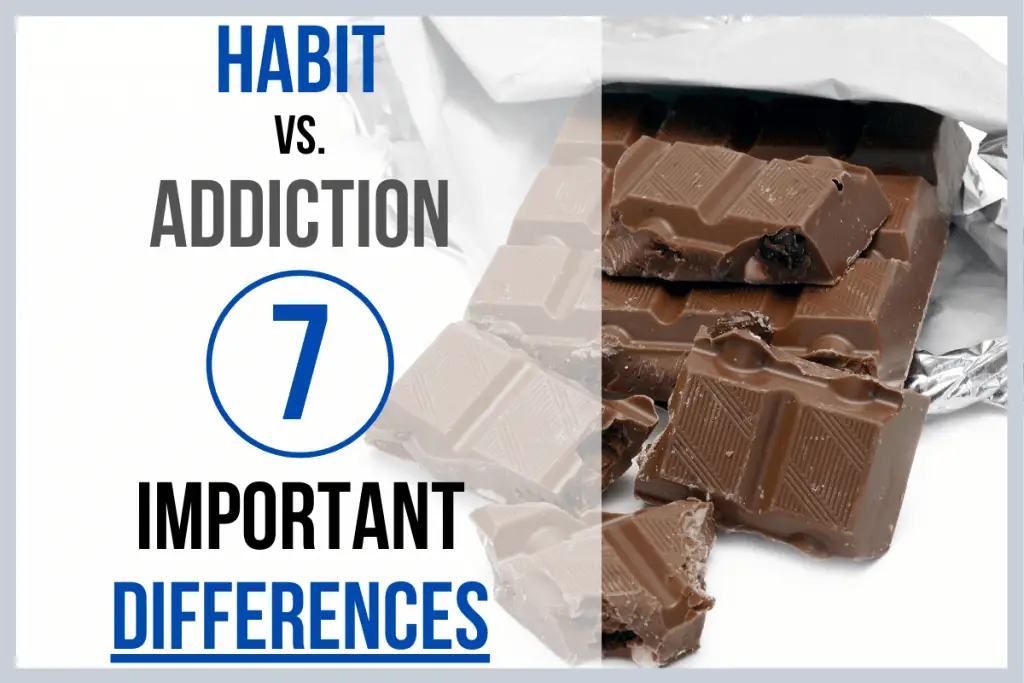 Under such conditions, the risk of developing a heart attack, stroke, thrombosis and angina pectoris increases.
Under such conditions, the risk of developing a heart attack, stroke, thrombosis and angina pectoris increases.
Abuse of chocolate negatively affects the condition of the skin. The high sugar content in the body provokes the growth of pathogenic microorganisms in the intestines, which disrupts the digestion process, develops allergic dermatitis, and acne occurs.
How to get rid of it?
Chocolate addiction causes health problems and therefore requires immediate treatment. One must remain patient and keep a positive mindset. Eliminating uncontrollable cravings for sweets can take several months, which requires a lot of willpower. Getting rid of addiction takes place according to the following algorithm:
- You need to admit to yourself that you have a psychological problem. A person must become aware of an unhealthy attitude towards chocolate, overcome the stage of denial and proceed to treatment.
- The diet needs to be adjusted.
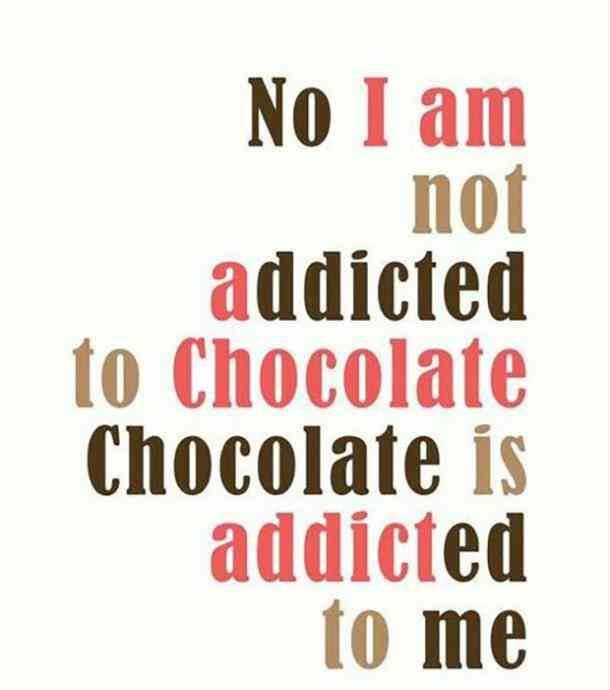 The body must receive all the necessary vitamins and minerals, so the daily menu should consist of 80% plant food, 20% protein products.
The body must receive all the necessary vitamins and minerals, so the daily menu should consist of 80% plant food, 20% protein products. Tip
To prevent deficiency of magnesium, phosphorus and zinc, eat seafood, bananas, nuts, broccoli and sour milk drinks.
- It will be necessary to gradually reduce the amount of sweets consumed. Abrupt refusal of chocolate can cause withdrawal syndrome, which manifests itself in the form of depression, exhaustion, chronic fatigue and dyspeptic disorders. It is necessary to reduce the consumption of chocolate to 50 g per day.
- The cause of the dependency needs to be removed. A person should avoid stressful situations, move more and not buy a lot of sweets.
Do not abruptly refuse or limit the consumption of chocolate. To stabilize the metabolism and hormonal background, it is necessary to find a suitable alternative to sweets. To replace dessert, the following products are suitable:
- Med.
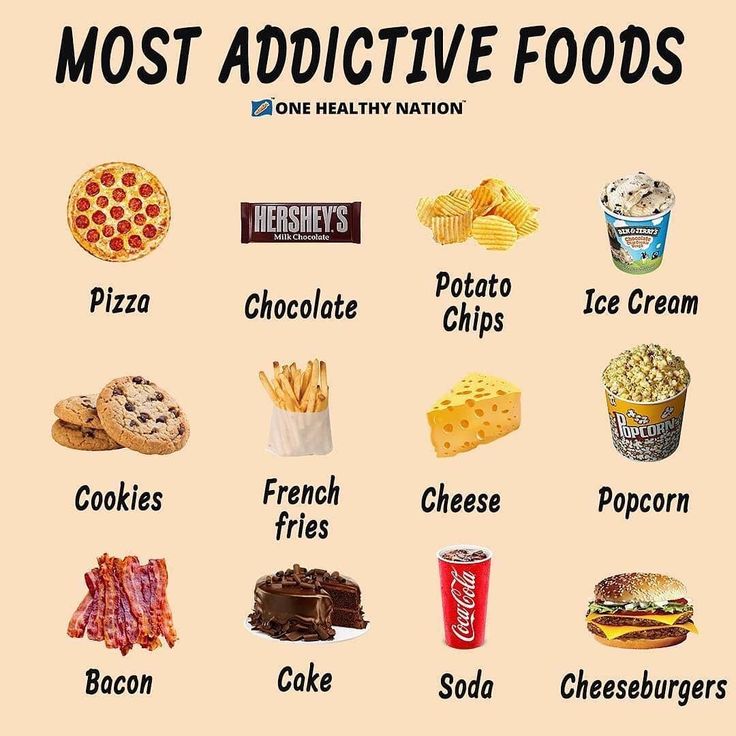 Bee product provides the body with vitamins and minerals, has a pleasant taste and smell. You should not abuse the product, because it contains potential allergens. They can cause swelling of the face, hives, rhinitis, and dermatitis. It is enough to use 1 tsp. honey with tea or in between meals.
Bee product provides the body with vitamins and minerals, has a pleasant taste and smell. You should not abuse the product, because it contains potential allergens. They can cause swelling of the face, hives, rhinitis, and dermatitis. It is enough to use 1 tsp. honey with tea or in between meals. - Dried fruits. Differ in a high content of magnesium and iron, which have a beneficial effect on the state of the circulatory system.
- Marmalade. Promotes the removal of slag masses and salts of heavy metals from the gastrointestinal tract.
- Homemade marshmallow. Contains a large amount of protein, phosphorus and iron. Reduces the excitability of the food center in the brain and satisfies hunger for a long time. Look.
You can make your own chocolate. There are no harmful impurities in the home-made product that cause addiction. In addition, in such a product, you can control the amount of sugar.
Attention!
Do not abuse chocolate substitutes. They contain a large amount of easily digestible carbohydrates, which can cause obesity and vascular problems.
Addiction to chocolate must be fought in order not to harm health. The abuse of sweets negatively affects the work of the cardiovascular, digestive and endocrine systems. Eating chocolate in large quantities causes allergies, acne, dyspeptic disorders.
Read more:
Articles written
Chocolate addiction: what is chocolate addiction
“Five out of ten respondents say they love chocolate. The tenth, as a rule, always tells a lie.”
(John Tullius)
Hundreds of the world's inhabitants daily experience this sweet temptation in different countries of the world: children and adults, scientists and educators, politicians and economists. Thousands of delicious chocolate bars leave store shelves every minute. It is consumed day and night, with coffee and tea, during depression and in moments of joy. What makes people buy chocolate by the kilo? And is it really possible to become addicted to it?
What makes people buy chocolate by the kilo? And is it really possible to become addicted to it?
What is chocolate addiction
Is there really a chocolate addiction? Doctors and psychologists say that it exists. The mechanism of getting into the sweet web is simple: advertising, suggestions, nervous breakdowns, unsuccessful personal life, problems at work, bad mood, and that's all - a person is on the hook. In search of a feeling of happiness, the patient buys chocolate without even paying much attention to it. The result is obvious: the mood improves and it seems that not everything is so bad in this world.
But the fact is that the composition of any chocolate includes cocoa , which contains substances that stimulate the production of phenethylamine - the hormone of joy (oily chemical compound, is the starting point for some natural neurotransmitters (biologically active chemicals with which the transmission of electrical impulse from the nerve cell through the synaptic space), and its derivatives are hallucinogens and stimulants).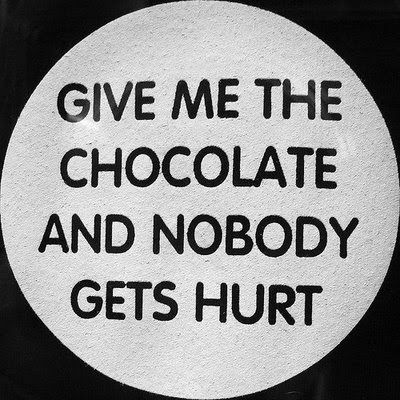 Therefore, after eating a bar of chocolate, a person really feels much better.
Therefore, after eating a bar of chocolate, a person really feels much better.
The content of sugar in this product also provokes addiction. When the human body is exhausted, it begins to demand something delicious. It doesn’t have to be pure chocolate: a chocolate-covered cake, pudding, anything as long as it’s sweet and high-calorie. It is worth taking into account the fact that cocoa beans also contain caffeine (xanthine alkaloid, which can be found in coffee tree beans, tea, mate, guarana berries, in small amounts in cocoa and nuts, cola), which is also capable of provoking addiction with its frequent consumption.
Chocolate addiction: symptoms
Chocolate addiction is a condition in which a person cannot control the amount of chocolate eaten, and is also unable to give up their favorite sweets:
-
Addicts usually eat the whole bar at once, they simply cannot deny themselves such pleasure.
-
Most patients are overweight, which is attributed to improper metabolism, gastric diseases, genetic predisposition to overweight and the like.
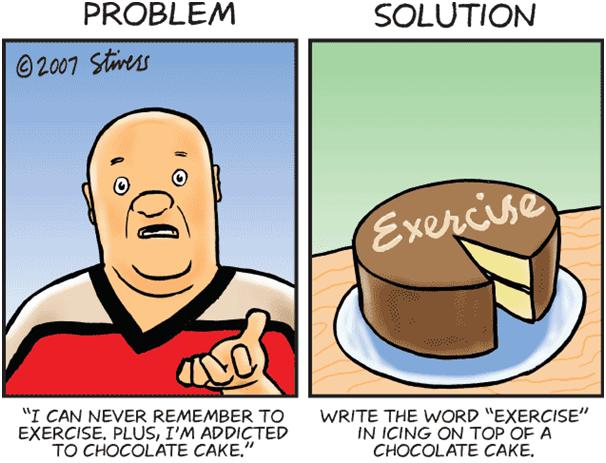
Although there are reasons for this: unrequited love, excess weight, own uncertainty and the like. Being stabbed in the back, the weak body defends itself by consuming an excess amount of chocolate, in other words, it heals mental wounds.
The healing properties of chocolate temptation: myth or reality
How to get rid of chocolate addiction? Doctors cannot answer this question, since chocolate contains more than 500 different components, so it is difficult to say what exactly causes addiction. However, many believe that chocolate addiction can be beneficial. Is it so?
Increasingly, one can come across information that chocolate is endowed with healing properties. Five years of research by medical scientists have proven that chocolate helps prevent the risk of heart failure . Women who take one to two servings of high quality chocolate with 75% cocoa content per week are 32% less likely to become victims of the above disease. If you use a small amount of chocolate (40-50 grams), you can improve your heart.
If you use a small amount of chocolate (40-50 grams), you can improve your heart.
This is useful to know:
Back to contents ↑
Based on their research, Canadian scientists confirm the benefits of chocolate: it can relieve a person of coughs. Chocolate contains theobromine (an alkaloid found in cocoa beans, less often in mate, tea, circle, guarani and coffee; antispasmodic and diuretic, similar in structure to caffeine, stimulates cardiac activity, dilates the vessels of the heart and brain, as well as bronchi, increases urination), which provides the body with protection against such a disease.
These medicinal properties are much lower than in antidepressants of sweet origin. Experts drew conclusions on the basis of the following experiment: several subjects who complained of sore throats were given medications, and others were given sweets, as a result, chocolate medicines won. Moreover, scientists and doctors note that the harm caused by chocolate to the human body is much less than imported expensive antibiotics. British doctor Roger Dobson (Roger Alan Dobson, a British writer, journalist, editor, literary researcher, doctor and scientist) advises eating chocolate for colds twice a day.
British doctor Roger Dobson (Roger Alan Dobson, a British writer, journalist, editor, literary researcher, doctor and scientist) advises eating chocolate for colds twice a day.
A study by the National Institute of British found that an alkaloid found in cocoa beans helps with coughing because it blocks the sensory nerves that are responsible for reflexes.
However, it is definitely impossible to replace medicines with chocolate, because such a practice can lead to serious complications after illness.
In 1960, a group of scientists from Finnish universities in Oulu and Helsinki carried out an interesting study. A team of specialists collaborated with Helsinki businessmen who were born in the time period from 1919 to 1934. Among the questions asked, financial tycoons were asked to tell which candies they like the most. Out of 1367 respondents, 860 people admitted that they love any chocolate and only 100 said that they do not consume sweets at all. Summing up, scientists came to the conclusion that chocolate lovers are slimmer and much less likely to suffer from diabetes .
